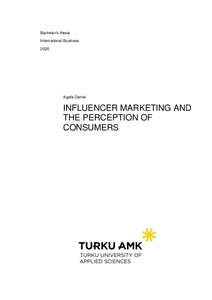Influencer marketing and the perception of consumers
Daniel, Agafa (2020)
Daniel, Agafa
2020
All rights reserved. This publication is copyrighted. You may download, display and print it for Your own personal use. Commercial use is prohibited.
Julkaisun pysyvä osoite on
https://urn.fi/URN:NBN:fi:amk-202005088069
https://urn.fi/URN:NBN:fi:amk-202005088069
Tiivistelmä
During the recent years, companies of different sizes have started to allocate more resources towards digital marketing. The digital marketing space is growing at a fast rate year by year.
There are many forms of digital marketing ranging from e-mail marketing to search engine marketing. One marketing form which has also been on the rise is influencer marketing, which this thesis is based on.
The researcher studied the topic of influencer marketing with the intent of focusing on mainly micro-influencers. The first objective of the research was to find reasons behind the efficiency of micro-influencers, these influencers have a smaller following compared to their counterparts, macro and mega-influencers.
The second objective was to define the most important social media platforms used by influencers. Lastly, the third goal was to study the perception of consumers towards influencer marketing, whether they feel this form of marketing to be aggressive or invasive or do they see influencer marketing in a neutral or even in a positive light.
The thesis was constructed using both primary and secondary data. The researcher first used secondary data in the form of literature such as books, magazines, existing studies and online sources, to form a solid base for the construction of the primary data. The created primary data was in the form of surveys targeted to consumers and an interview conducted with a Finnish YouTuber/ social media influencer.
Both forms of data provided similar results. The main reason behind micro-influencer efficiency in influencer marketing being their ability to more effortlessly interact with their followers, resulting in creating a very relatable, trustworthy and approachable image, either by purposely trying to create that kind of image or by organically creating it as a ‘by-product’.
Results also revealed that Instagram and YouTube are the most used social media platforms by consumers, therefore they hold the most potential value for influencers and influencer marketing.
Lastly, results revealed the consumer’s perspective towards influencers and influencer marketing is quite positive, even individuals who do not follow influencers on social media, do not see paid posts as a negative element, in addition to a majority of respondents would at least consider buying a product or service through an micro-influencer.
There are many forms of digital marketing ranging from e-mail marketing to search engine marketing. One marketing form which has also been on the rise is influencer marketing, which this thesis is based on.
The researcher studied the topic of influencer marketing with the intent of focusing on mainly micro-influencers. The first objective of the research was to find reasons behind the efficiency of micro-influencers, these influencers have a smaller following compared to their counterparts, macro and mega-influencers.
The second objective was to define the most important social media platforms used by influencers. Lastly, the third goal was to study the perception of consumers towards influencer marketing, whether they feel this form of marketing to be aggressive or invasive or do they see influencer marketing in a neutral or even in a positive light.
The thesis was constructed using both primary and secondary data. The researcher first used secondary data in the form of literature such as books, magazines, existing studies and online sources, to form a solid base for the construction of the primary data. The created primary data was in the form of surveys targeted to consumers and an interview conducted with a Finnish YouTuber/ social media influencer.
Both forms of data provided similar results. The main reason behind micro-influencer efficiency in influencer marketing being their ability to more effortlessly interact with their followers, resulting in creating a very relatable, trustworthy and approachable image, either by purposely trying to create that kind of image or by organically creating it as a ‘by-product’.
Results also revealed that Instagram and YouTube are the most used social media platforms by consumers, therefore they hold the most potential value for influencers and influencer marketing.
Lastly, results revealed the consumer’s perspective towards influencers and influencer marketing is quite positive, even individuals who do not follow influencers on social media, do not see paid posts as a negative element, in addition to a majority of respondents would at least consider buying a product or service through an micro-influencer.
